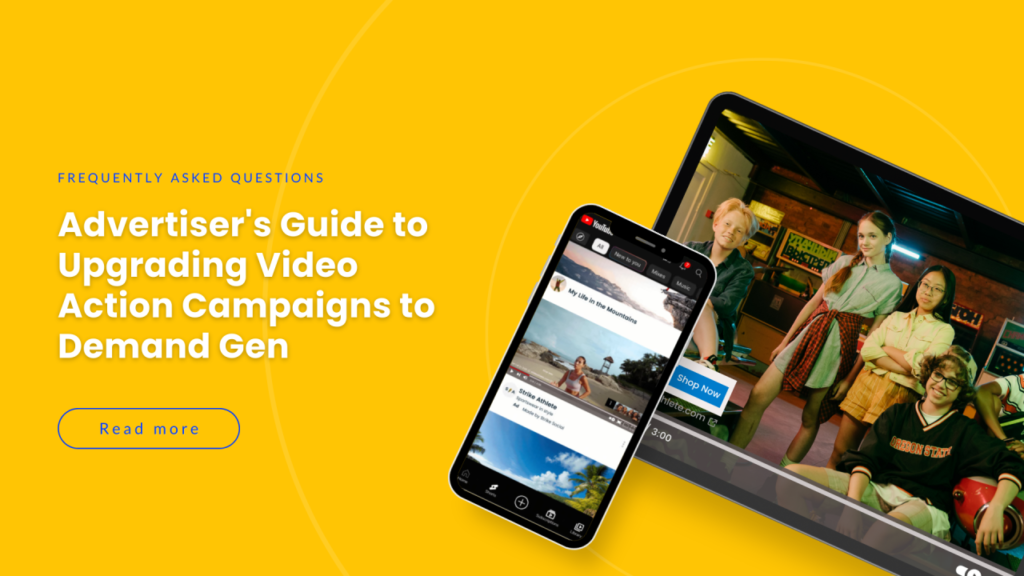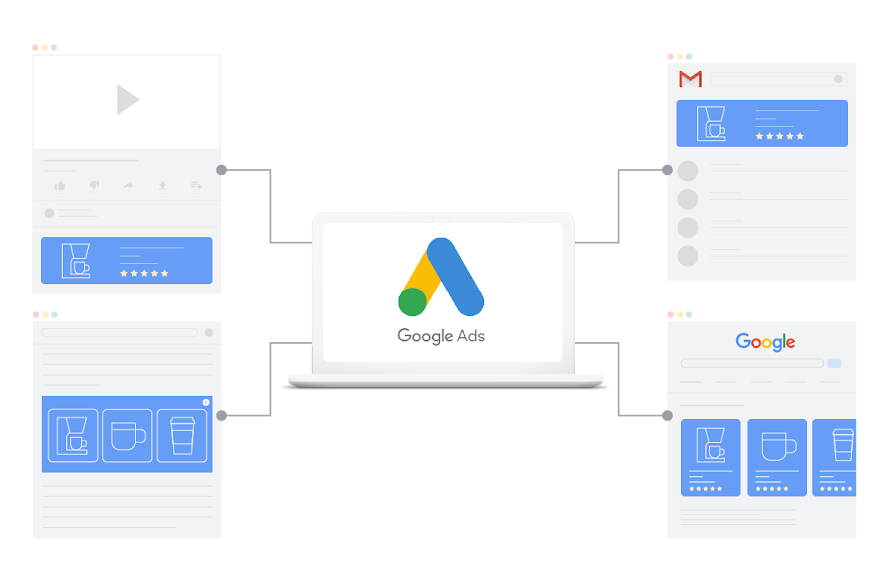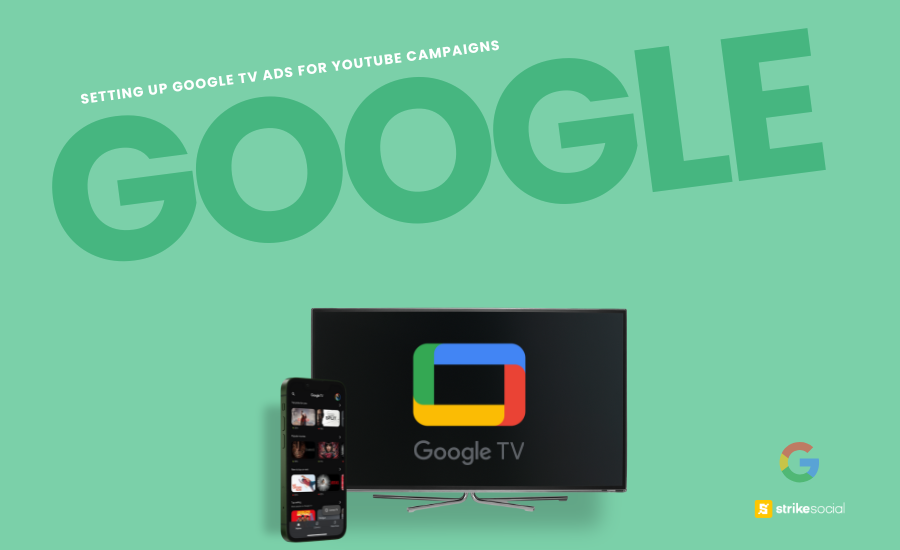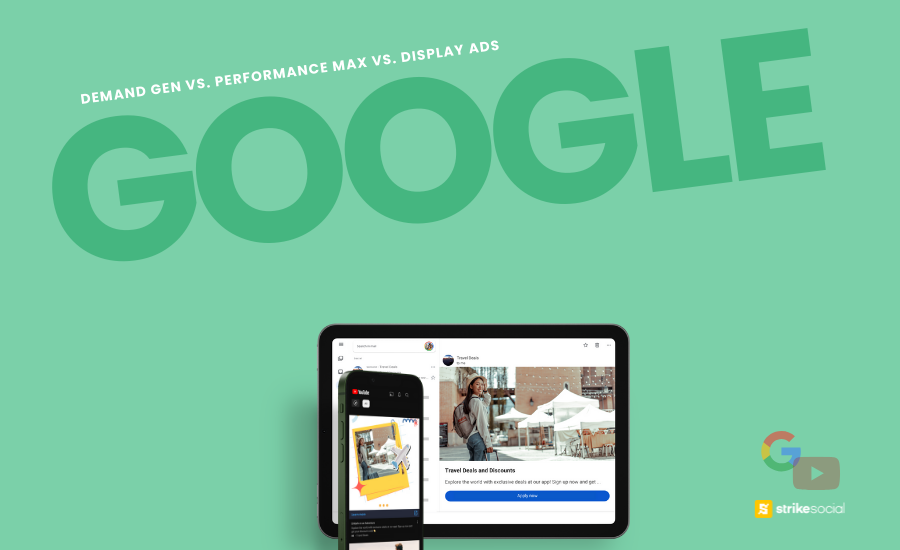Strike Overview
- With Video Action Campaigns transitioning to Demand Generation soon, advertisers ask: Can we still differentiate Demand Generation vs. Performance Max? Additionally, can we distinguish between Demand Generation vs. Display Ads among Google ad inventory types?
- Preparing for the transition of Video Action Campaigns to Demand Gen is just as necessary, even if it’s set to begin in Q2 2025. Apart from starting with the shift, we believe it’s important to distinguish between these Google ad campaign types so you know what works best for you.
- This blog will help you with a quick comparison and recommendations as you enter 2025 – to help you make your brand even bigger and more powerful as you advertise on Google and YouTube.
Jump to Section
Get exclusive content on paid social media.
Join our mailing list for the latest updates.

When to Use Demand Gen, Performance Max, or Display Ads?
Previously known as Video Action Campaigns (VAC), these YouTube ads were designed to drive actions such as clicks, purchases, and website traffic—primarily through YouTube and Google video partners. With the introduction of Demand Gen, these capabilities are expanding to include placements on Gmail and Google Discover, going beyond the traditional YouTube video ad format.
However, if you’re running multiple Google ads, YouTube, and YouTube TV-centered campaign types, you might notice some overlap in functionality and placements. This guide breaks down the distinct features to differentiate Demand Gen vs. Performance Max vs. Display Ads, helping you determine which one best aligns with your goals in 2025.
Demand Gen vs. Performance Max
As Demand Gen expands the YouTube ads inventory to include placements on Discover and Gmail, it’s easy to see why advertisers might confuse it with Performance Max (PMax) campaigns. Let’s break down the differences to help you distinguish between the two.
What is Demand Gen in Google?
Demand Gen is a Google campaign type designed to drive sales and create demand by reaching audiences at various stages of their customer journey. Replacing Video Action Campaigns (VAC), Demand Gen is an upgrade for YouTube app and YouTube TV advertisers, offering the familiar VAC functionalities while expanding placements and adding more advanced targeting options.
Further Reading

Advertiser’s Guide to Upgrading Video Action Campaigns to Demand Gen
Demand Gen campaigns take the strengths of Video Action Campaigns to the next level, offering advanced tools and features designed to expand your reach and boost performance. Discover how this upgrade can help boost your YouTube and Google ad performance.
What is a Performance Max (PMax) campaign?
Performance Max (PMax) campaigns prioritize delivering conversions and maximizing results based on the advertiser’s specific goals. Powered by Google’s advanced AI, PMax optimizes performance across various channels, including YouTube, Display, Search, Discover, Gmail, Maps, and other Google advertising networks, to achieve full-funnel efficiency.
What is the difference between Google Performance Max and Demand Gen?
Here’s an illustration of the key differences between Demand Gen vs. Performance Max to give a better view.
| Aspect | Demand Gen | Performance Max |
|---|---|---|
| Campaign objectives | Mid-funnel (awareness, consideration) | Lower-funnel (conversions, sales) |
| Targeting capabilities | Granular targeting options such as keywords, interests, and in-market audiences | Automated targeting based on user signals and campaign goals, reaching users across various platforms |
| Supported ad formats | Video ads, image ads, product feed ads | Text, images, videos, and interactive elements |
| Placements | YouTube, Discover, Gmail, Video Partners | Search, YouTube, Display, Discover, Gmail, Maps, Shopping |
| Ideal for | Brand building, lead generation | Conversion-driven campaigns |
When should you use Performance Max?
Performance Max (PMax) is designed to maximize conversion value by allowing Google’s AI to optimize ad placements across its ecosystem. While this automation may reduce granular control, the trade-off is higher efficiency for lower-funnel goals like conversions or clicks.
Notably, updates from Google Marketing Live 2024 introduced placement reporting and exclusions for YouTube, enhancing brand safety and giving advertisers more transparency over their campaigns. If your primary goal is conversions, PMax is an excellent option for driving results.
When to use Demand Gen?
As an upgrade from Video Action Campaigns (VAC), Demand Gen maintains its ability to prompt actions like website visits or sign-ups but now offers expanded functionality.
- Primarily powered by video ads, Demand Gen has evolved into a broader campaign type that includes image ads and carousel formats, extending placements to Gmail and Discover.
- Though previously centered on the YouTube app and YouTube TV, Demand Gen now supports multiple ad formats while maintaining precise control over targeting, ad placements, and formats.
- You’ll also retain robust brand safety and suitability controls, including content theme exclusions, inventory type selection, and placement filters, ensuring your ads align with your desired contexts and themes.
Demand Gen vs. Display Ads
Another common comparison arises between Demand Gen and Display Ads, as both primarily utilize visual formats like images and videos. Let’s explore the key differences of Demand Gen vs. Display Ads to help clarify when to use each for your 2025 ad strategy.
What is Display Ads in Google?
As the name suggests, Display Ads utilize various methods to display your ads across different placements within the Google Display Network. They have a “native” appearance, blending seamlessly with the design elements of the website or app, making them feel less intrusive and more naturally integrated with user behavior and the platform’s environment.

What is the difference between Demand Gen ads and Display ads?
How do you determine the strategies for using Demand Gen campaigns or Display ads? Each Google ads type serves a different purpose and employs different tactics, as seen below:
| Aspect | Demand Gen Ads | Display Ads |
|---|---|---|
| Campaign objectives | Awareness, lead generation, lead nurturing | Awareness, engagement |
| Targeting capabilities | Granular targeting options such as keywords, interests, and in-market audiences. More control over placements to enhance audience engagement | General targeting capabilities, including retargeting past visitors. Less control over specific audience segments compared to Demand Gen. |
| Supported ad formats | Video ads, image ads, product feed ads | Banner ads, rich media, video, interactive elements |
| Placements | YouTube, Discover, Gmail, Video Partners | YouTube; Over 200 million sites, apps, and videos within the Google Display Network (includes third-party sites) |
| Ideal for | Acquiring leads and building a sustainable pipeline of qualified prospects | Gaining quick visibility and boosting brand awareness |
How Demand Gen and Display Ads Can Complement Each Other
While Demand Gen and Display Ads serve distinct purposes, they can work together effectively:
- Google Display Ads provide initial exposure, reaching a broad audience to generate awareness.
- Demand Gen campaigns nurture this exposure by targeting specific audiences with tailored ads, focusing on engagement and lead generation.
Further, if your campaign sees higher engagement with video ads, you can better enhance your strategy by implementing Video View Campaigns, which optimize placements within the YouTube app and YouTube TV. During peak seasons, such as holidays, combining these strategies can lead to up to 5.3 million video views, maximizing YouTube ads visibility and engagement when it matters most.
By leveraging the strengths of different Google ad campaign types, you can create a balanced, multi-funnel approach that drives brand visibility and effectively nurtures potential customers.
Further Reading

Conquering Bigger Screens with YouTube TV and Google TV
YouTube TV and Google TV provide an excellent opportunity to extend your campaign’s reach and amplify brand awareness. Advertisers can connect with broader and more diverse audiences by tapping into premium TV ad inventory, including major networks and specialized channels.
How to Choose Between Demand Gen, Performance Max, and Display Ads
Your 2025 strategy should not be constrained by just a one-year-long campaign. Throughout the seasons, we provide you with different strategies as the different holidays arrive and different trends change advertising and consumer behavior.
Each of Google’s campaign types—Demand Gen, Performance Max, and Display Ads—serves unique purposes, making them ideal for different priorities. Here’s a breakdown to help you decide which types of Google ads align best with your goals:
| Advertiser’s Priority | Best Choice | Reasoning |
|---|---|---|
| Maximum Reach | Display Ads | Allows placements across Google Display Network (GDN), reaching over 90% of internet users worldwide, for the broadest exposure possible. |
| Maximum Conversions | Performance Max | Highly focused on driving conversions and utilizes Google’s AI to optimize for the best-performing combinations of audiences, placements, and creative assets. |
| Full-Funnel Coverage | A Combination of Approaches | Top of Funnel: Demand Gen or Display Ads (brand awareness, consideration) Mid-Funnel: Demand Gen (lead generation) Bottom of Funnel: Performance Max (conversions, sales) |
| More Granular Targeting | Demand Gen or Display Ads | Offers more control over targeting within its specific set of placements. Provides a wider range of targeting options, including contextual targeting, audience targeting, remarketing, and placement targeting. |
| Enhanced Brand Safety Controls | Demand Gen | Gives advertisers more control over where their ads appear, reducing the risk of brand safety issues associated with automated placements. |
| More Diverse Ad Formats | Performance Max | Supports a wide variety of ad formats including text, images, video, and interactive ads, catering to different campaign objectives. |
| Video-Ad/Visual Focused Campaigns | Demand Gen | Primarily focuses on visually-rich platforms (YouTube, Discover, Gmail) and allows for the use of various video and image formats. |
How Does Your 2025 Google and YouTube Ad Strategy Look Like This 2025?
Still pondering how you want to build your 2025 Google and YouTube ads strategy? We invite you to chat with us for a personalized walkthrough. Let us know what ad creatives you have, how you want to leverage them, and what your goals are so we can help you attain them.
With Strike Social’s proprietary tool, Campaign Lab, we’ve powered millions of successful campaigns, delivering measurable results and cost efficiency for our clients. Our unique Software with a Service (SwaS) approach combines advanced machine-learning technology with expert support to ensure your campaigns perform at their peak.
Contact us today and discover how we can help you maximize your 2025 Google and YouTube ads strategy.
Article by
Lee Baler, Strike Social’s VP of Sales & Strategy
Lee leads global strategy, helping clients and agencies maximize YouTube and paid social performance. Constantly tracking industry trends, he translates insights into strategies that help brands stay competitive and achieve sustained profitability.








